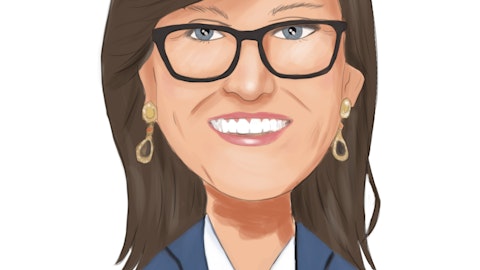MoneyLion Inc. (NYSE:ML) Q4 2022 Earnings Call Transcript March 14, 2023
Operator: Hello and welcome to the MoneyLion Q4 2022 Earnings Conference Call and Webcast. A question-and-answer session will follow the formal presentation. As a reminder, this conference is being recorded. It is now my pleasure to the call over to Sean Horgan, Head of Investor Relations. Sean, please go ahead.
Sean Horgan: Thank you. Welcome everyone to MoneyLion’s fourth quarter and full year 2022 earnings conference call. Joining me today to talk about our results are MoneyLion’s CEO, Dee Choubey; and CFO, Rick Correia. You can find the presentation accompanying our earnings release on the Investor Relations section of our website. Please note that any forward-looking statements made in this commentary are subject to our Safe Harbor statement found in our SEC filings and in our earnings press release. And now, I like to turn the call over to Dee.
Dee Choubey: Thank you, Sean. Good morning and welcome everyone to our fourth quarter and full year 2022 earnings presentation. I’m sure everyone has become a banking industry expert over the weekend, so we won’t rehash much here other than to say that we have no concerns regarding our business or operations in light of the Silicon Valley Bank rescue. This was the weekend our technology proved resiliency with near instant fallbacks to alternative processing and with no impact to our customers. We’ll focus instead on the many positives about our results and our trajectory and why we are positioned to thrive. We are built to endure in good times and importantly the challenging times, so our customers and our enterprise clients can count on us.
I couldn’t be more proud of our people, their dedication to our mission and the sophistication of our infrastructure, a technology stack that has proven to be one of the best in fintech on the foundation of a proven business model, a proven technology infrastructure and a proven management team. I’m pleased to share our Q4 and 2022 full year results. Despite the most turbulent operating environment in decades, 2022 was another year of record performance for MoneyLion. Through our unique combination of assets, we have built a powerful platform to power money decisions for a broad segment of American consumers. We continued innovating. We continued providing services while solidifying our place as a trusted money destination for everyone. We’re now at a point in our evolution as a company where we drive efficient growth.
Our adjusted revenue grew nearly by 100% year-over-year to over $328 million from $165 million in 2021. We made substantial progress towards profitability and improved our adjusted EBITDA each quarter sequentially throughout the year. And so as not to bury the punch line, we ultimately exited the year with positive adjusted EBITDA for the month of December. We look at this as a huge achievement that our team worked very hard to deliver. In a snapshot, in 2022, our business reached significant scale. We exited the year with 6.5 million total customers and our definition of customers, as you know, points to monetize customers as opposed to those that just browse our platform. 12.9 million total products were taken by those customers and we ended the year with over 1,000 enterprise partners and we amassed over 33 million unique customer profiles across our platform.
We also enhanced our product offerings to consumers complemented by our dynamic content that encourages our customers’ exploration of ideas, advice and insights regarding their financial lives. We launched Discover, a personalized content feed to deliver trending money adjacent topics through videos to customers based on what is most relevant to their financial lives. We introduce things like playlists where we present dynamic topic driven content bundles and MoneyLion original series to deepen engagement on relevant and popular topics. For our core suite, a first party products, we added invaluable features intended to expand lifetime value and drive product usage, including, for example, MoneyLion pay for our digital bank account holders, our peer-to-peer money transfer feature through which digital banking customers can send and receive money to anyone.
We also continued expanding on the breadth of financial and non-financial product and service offerings available in our consumer marketplace. And as part of our continued evolution of our membership model, we’re in the process of launching a new membership, which will provide members with additional exclusive premium features and engagement opportunities at a lower monthly price. As we look ahead, we believe 2023 will be the year we turn the corner towards profitable growth. Many of our peers are dependent on massive marketing expenditures to acquire customers. This capital intensive approach is not sustainable in the long run and has become untenable in the current environment, which is why we have created favorite acquisition approaches that deliver consistently attractive unit economics at excellent customer acquisition costs and payback periods.
Rick will talk to you more about this later in the presentation. We have a laser focus on our near term efforts that we believe will drive profitability. First, we’ll continue to drive efficiencies in our operating expenses. We expect to see leverage in other expenses, professional fees and net interest expenses in 2023 compared to 2022. Remember 2022 was our first full year as a public company and we incurred significant readiness expenses that we now have rationalized. Second, we will prioritize our most profitable business lines. And third, we’ll continue to leverage our differentiated customer acquisition strategy and optimize our marketing spend. MoneyLion has a talented, experienced and innovative leadership team in place to continue navigating through any economic environment and our platform is positioned to balance an attractive combination of growth and profitability in the medium term.
Turning to our customer growth, we added over a million new customers in Q4 2022, a record number of quarterly customer adds while maintaining very disciplined levels of marketing spend. Why this is important and noteworthy? Our financial super app works. We’re effective at the cross-sell and the life cycle across the consumers’ financial inflection points. It also shows that consumers continue to look for tailored financial products away from traditional sources. Our integrated consumer enterprise and media capabilities continue to allow us to land and expand with the consumer. This is a testament to the self-reliant ecosystem we’ve built, which leverages a large top of the funnel to drive low customer acquisition. You’ll notice this throughout the year over and over as we decline our marketing expenditure and you’ll see this happening from 2021 to 2022.
Cost effective customer acquisition and then lifetime value maximization is one of our biggest competitive advantages. The network infrastructure acts as a pulling mechanism. We match customers with an expansive suite of products with relatively little incremental investment. In effect, we require lower costs to scale our customer base relative to many of our peers. Turning to product consumption, expanding products to meet our customers’ needs while increasing lifetime value is a key tenant to our strategy. By the end of 2022, 12.9 million total products were consumed on our platform, up from 8 million at the end of 2021. 66% of these products consumed in Q4 2022 were third-party products compared to just 10% in Q1 2021, reflecting how our content and marketplace synergies were driving broader product consumption and deepening our relationship with customers by matching them with the products they need.
By continuously delivering on client needs, we extend lifetime value and feel the recurring revenue profile of the platform. Before I provide an update on each of our businesses, let me first touch on what I believe are the three key investor takeaways of today’s presentation. First, we reached positive adjusted EBITDA December 2022. This was our fourth consecutive quarter of adjusted EBITDA improvement and marks significant milestone towards quarterly profitability. Looking ahead, we expect positive adjusted EBITDA in fiscal year 2023 reflecting our continued commitment to driving profitable growth in 2023 and beyond. Second, we added over a million total customers in Q4 2022. We achieved this record number of quarterly new customers while maintaining a customer acquisition cost of less than $10.
MoneyLion’s strong unit economics are a result of the flywheel effects underpinning our business model. This is highly differentiated in the industry and it allows us to play to our advantages, which are our data and technology assets. We expect this to continue being an advantage throughout 2023. And third, MoneyLion reached record quarterly adjusted revenue of $92 million in Q4 2022. This compares to $54 million in Q4 2021. In addition, we delivered nearly 100% year-over-year growth for full year 2022. Our diversified consumer and enterprise businesses play off of each other in a complementary way, and this provides us durability through different economic environments. There are natural hedges built into our revenue generation capabilities.
Let’s take a closer look at our consumer and enterprise businesses. Our consumer business remains very strong in a testament to our ability to innovate, build, iterate, and operate at scale. Consumer demand remains resilient despite concerns of a worsening economic environment. On a first party basis, we have over a decade of experience now managing credit risk on behalf of our partners in times of excess and in times of need leading to resilient credit performance. Provision as a percentage of originations was 4% in Q4. This is at the low end of our target range of 4% to 6% and reflects our continued ability to manage credit performance throughout cycles. The provision expense and our warehouse cost of capital from which we financed the originations remained well in line to ensure we’re driving consistent positive unit economics.
In Q4, we saw strength across the board on our unit economics both gross and net throughout our consumer division. Nevertheless, our must have products on the consumer side remain critical for American families in times excess and in times of need. And as we take market share, we will continue to see improving unit economics powering us towards an attractive EBITDA profile. To sum it up, our consumer offering is a full feature money app intended to serve the financial needs of anyone and more features equal more monetizable aha and delightful moments. We have a robust suite of products that we believe is unrivaled in the marketplace today. Our first-party products and services include digital banking with direct deposit and two day early paycheck capabilities, investing offering both managed investing and with our new membership, single stock and ETF investing.
Rewards such as cash back and other exclusive offers, roundups, invest with roundups and everyday purchases with any debit or credit card, cash advances to provide consumers with flexibility and help cover unexpected expenses, peer-to-peer payments, send money to friends on and off MoneyLion, our Credit Builder loans to help improve credit scores, our crypto roundups to buy or sell directly with roundups on our platform, our AI powered personal financial management insights offering personalized recommendations, credit monitoring of credit scores and money adjacent content with search and discover functionalities. We also complement our consumer offering with a broad suite of third-party products and offerings from our network of partners. These include insurance, high-yield savings, loans, credit cards, tax preparation, as well as a variety of budget sensitive products and offerings and categories like auto to access telematic driving scores to unlock cheaper insurance, buying or selling a vehicle or finding a car to rent through for an upcoming trip.
We’ve expanded into travel to join frequent-flyer programs or take advantage of hotel rewards our home to get repairs on savings or utilities. And finally, if we’re looking to earn more, finding a side hustle. We’re making progress towards being a truly must have product for all American consumers. Moving to the enterprise business, we provide important marketing infrastructure. Our marketplace powers the biggest players in FinTech and traditional finance. First, our marketplace is not immune to the macro environment. In fact, we faced unanticipated weaknesses from reduced marketing spends and increasing interest rates beginning Q2 of 2022. Despite those industry headwinds, demand continued to increase in Q4 as end consumer demand remained robust for financial products across our marketplace.
Marketplace supply from our financial institution product partners in Q4 improved modestly compared to Q3, but decidedly remained below levels we saw on the first half of the year. We’re now well positioned for revenue growth on our network one that supplier rebounds to normal levels. Regardless of the environment, our sales efforts have been an area of strength. We continue to target and win new business opportunities from new and existing enterprise partners. We are also seeing increased adoption by our product partners for enterprise web services that provide analytics, business intelligence and proprietary insights. From these, we generate additional platform and usage fees. This is driving higher LTV through deep integrations, which I will talk more about in a minute.
As a one-to-many network providing a single point of integration for supply and demand, we create a powerful engine for real-time, personalized financial products and service search. In addition, our platform enables us to provide data and analytics reporting and benchmarking services to help better decisioning for our partners. This is a great opportunity for us to increase our portion of platform fees and SaaS-based revenue unlike unlocking more value off of our existing network. We’re generating multiple transaction-based and SaaS-based revenue streams with a suite of web services already available to enterprise clients and with future launches in development. We sit in the middle of a broad network of channel partners and product partners, providing connectivity between communities of consumers and financial product providers.
Product partners are able to efficiently acquire high intent customers through relevant channels, which provides great conversion at a low cost. Over 400 product partners leverage their network to match their products with the right consumers. As a result of our deep integrations and growing suite of value-added services, we have seen consistent recurring revenue from historical cohorts. Rick will touch more on this during our financial update. All in one, MoneyLion provides the ultimate platform for embedded finance, marketplaces, products, media and data. Underpinned by the power of open banking and consumer data our technology combines a vast marketplace of first and third party products to match consumers with the best products through easily digestible content and advice.
Our ability to acquire record quarterly new customers while maintaining consistent levels of marketing spend in Q4 is a result of the flywheel effect inherent in the ecosystem we methodically have built over the last two years. As we look forward, we expect to iterate on our data advantage and continue to take shared increasingly attractive incremental margins. With that, I’d like to pass it off to our CFO, Rick Correia for a financial update.

Copyright: prykhodov / 123RF Stock Photo
Rick Correia: Thanks Steve. And good morning to everyone. I look forward to sharing details about our record financial performance for the fourth quarter and year ending December 31, 2022. I will also discuss our guidance and outlook for the first quarter and full year 2023. As we are going through the financials please note that unless otherwise stated, I will be referring to adjusted results in all quarterly period references referred to the fourth quarter of 2022 versus the fourth quarter of 2021. Our GAAP consolidated financial statements and non-GAAP reconciliations are available in today’s earnings release and our 10-K filing. As Dee mentioned in his prepared remarks, MoneyLion has been able to consistently acquire new customers incredibly efficiently.
So I want to take a minute to unpack how we are able to do this quarter-over-quarter, year after year. Our customer acquisition and lifecycle strategy is deliberately designed to acquire customers with attractive unit economics that we expect will ultimately lead to profitability. Starting at the top of the funnel, our marketing mix is composed of a diverse set of channels, including marketplace, brand, influencers, organic and paid digital. In 2022, these channels translated into 115 million total inquiries, which represents the number of submitted consumer applications for the financial products across our marketplace business, MoneyLion app installs, and users who have registered via the MoneyLion website. These high intent inquiries translated into the acquisition of 3.2 million new customers over the course of 2022, leading to 6.5 million of total customers by the end of 2022.
Given our diverse set of channels for customer acquisition, we were able to acquire this record level of new customers, while also reducing our overall marketing spend by 14% in 2022 versus 2021. Importantly, our vast product breadth enables our customers to find what they need all in one place. We added 4.9 million incremental total products by our customers during the year, leading to 12.9 million total products consumed by the end of 2022. Our vast set of first and third party products that Dee described earlier, as well as our quantitative lifecycle engine, powers product consumption and cross-sell resulting in two products per customer by the end of 2022. At a high level, this machinery allows us to acquire customers more efficiently and monetize more effectively than if we were a monoline product provider and dependent on a single acquisition channel.
Now let’s see how this translates to our recent trends in our unit economics. We added a record 1.1 million new customers in the fourth quarter with fully loaded acquisition spend in the quarter of only $9 million. Our fully loaded CAC was $8 in the fourth quarter, down from $25 in the prior year period. Our payback period was approximately two months in the fourth quarter of 2022, down from four months in the prior year period. ARPU was $62 in Q4, slightly lower from last quarter as we continue to scale our user base at a significant pace. This ARPU represents a growing mix of new customers, which historically reached higher ARPU levels as they mature. As we look forward, we expect to maintain attractive unit economics and efficient acquisition levels in 2023.
We also continue to see high levels of recurring revenue from customers across our consumer and enterprise businesses in 2022. Starting with consumer. In 2022, over 75% of our consumer adjusted revenue came from historical cohorts. As you can see, customers from historical cohorts have consistently returned to us to consume our products, reflecting both the value of our products and the stickiness of our revenue in the consumer business. We have the same trend in our enterprise business. In 2022 over 85% of adjusted revenue from our enterprise marketplace came from prior year cohorts. The value of our platform and our deep software and infrastructure integrations result in consistent recurring revenue from our product partners each quarter.
As you can see, our high percentage of recurring revenue and lifetime value extension is proof that we are consistently meeting the needs of both our consumer and enterprise customers, which is fundamental to our resilient business model. We saw continued strength in consumer origination performance in the fourth quarter. Total originations were $496 million in Q4, accelerating to 11% quarter-over-quarter growth in Q4 from 2% in Q3. Our provision expense as a percentage of originations was 4% in Q4, which is at the low end of our target range of 4% to 6%. To be clear, for this metric, low is good. This reflects our success in maintaining credit performance despite broader concerns across the industry. To this end, we will continue conservatively managing originations to prioritize our highest quality customers as we navigate through 2023.
Adjusted revenue for the quarter grew 71% year-over-year to $92 million, marking another record quarter for MoneyLion. For the full year of 2022, our adjusted revenue reached $328 million, up 99% year-over-year, and at the high end of our most recent guidance for the year. Turning to our revenue mix, our consumer business contributed to 65% of our adjusted revenue in the fourth quarter, up from 60% in Q3. Strength across our consumer business and seasonal spending benefits contributed to the increase in overall mix in the fourth quarter. Our enterprise business contributed 35% of our adjusted revenue in the fourth quarter down from 40% in Q3. Ongoing headwinds from tighter credit standards and reduced marketing spend by our clients in our enterprise business contributed to the decrease in the fourth quarter.
While there is a synergistic relationship between our consumer and enterprise businesses, it is also the stalwart of business resiliency as we offset enterprise headwinds with consumer revenue outperformance. In Q4 2022, we generated $58 million of adjusted gross profit, representing 62% gross profit margin, an improvement from 58% in Q3. Full year 2022 adjusted gross profit was $195 million, representing a 59% gross profit margin compared to 63% in 2021. We continue to target gross profit margins in the range of 55% to 65% over the medium term. As our mix shift normalizes, our portion of recurring enterprise platform fee revenue increases and we benefit from economies of scale. Now onto our path to profitability. In 2022, we set out to make significant headway towards profitability and we made progress on that front each quarter of the year.
Adjusted EBITDA in the fourth quarter was negative $6 million compared to negative $32 million in Q4 2021 and marked our fourth consecutive quarter of significant adjusted EBITDA improvement. Our adjusted EBITDA of negative $6 million represents a beat over our implied Q4 EBITDA guidance of negative $12 million to negative $7 million. Importantly, we reached positive adjusted EBITDA in December of 2022. Margin improvement in Q4 was driven by strong consumer performance, enterprise margin expansion, continued benefits of operating leverage, and the roughly $15 million of annualized fixed cost reductions actioned in the quarter. We ended the year with $154 million of cash in our balance sheet, providing with adequate runway as we reach profitability in 2023.
Separately, in connection with the company’s annual goodwill impairment testing, we expect to record a non-cash impairment charge of approximately $140 million. The impairment charge is attributable to the decline in the company’s stock price and related market capitalization, resulting from the adverse macroeconomic market conditions. It is important to note that goodwill impairment charge does not affect the company’s cash position or have any impact on our future operations, and we’ll remain highly encouraged about our growth prospects and path to profitability in 2023. Turning to guidance, in Q4 2022, adjusted revenue was $92 million, which was at the high end of our implied range of $84 million to $94 million. Adjusted gross profit was 62%, which was at the high end of our implied range.
And adjusted EBITDA of negative $6 million was also a beat versus the implied range of negative $12 million to negative $7 million. With this momentum in Q1 2023, we expect adjusted revenue of $85 million to $88 million reflecting a 30% year-over-year growth. This level of growth reflects our deliberate focus on optimizing profitability and growth, while we navigate a relatively uncertain economic environment. We expect adjusted gross profit margin in the range of 58% to 62%. This slightly higher level of gross profit margin reflects a mix of higher margin consumer revenue similar to Q4 2022. We expect adjusted EBITDA in the range of negative $4 million to break even, this reflects almost 400 basis points of margin improvement compared to Q4 2022.
Lastly, for the full year of 2023, we expect positive adjusted EBITDA marking our first full year of adjusted EBITDA profitability as a public company. As we continue to drive operating leverage we also expect to reach positive quarterly adjusted EBITDA in 2023. We are incredibly proud of the MoneyLion team that has achieved so many important milestones in 2022, setting us on a great trajectory for 2023. With that, I’ll turn it back over to Dee for closing remarks.
Dee Choubey: Thanks Rick. 2022 was a tough year for most high growth tech and fintech companies, no doubt. We were able to navigate this environment while thoughtfully optimizing our investments and ultimately reaching positive adjusted EBITDA in December as we exited the year. We made this progress all the while still growing our top line adjusted revenue by nearly a 100% year-over-year. Our unit economics remain strong, which we expect to continue going forward and contribute to incremental profitability in 2023. 2022 was a year of building the ecosystem that MoneyLion is today while optimizing the inherent advantages and efficiencies in our business model. As we turn the corner on profitability, we believe 2023 will be the year MoneyLion reaches profitable growth at scale. Thank you very much for joining us today, and we look forward to taking your questions.
See also 15 Biggest Window Manufacturing Companies and 12 Biggest Ocean Cleaning Companies in the World.
Q&A Session
Follow Moneylion Inc.
Follow Moneylion Inc.
Operator: Thank you. Our first question today is coming from Josh Siegler from Cantor Fitzgerald. Your line is now live.
Keeler Patton: Hi guys, this is Keeler on for Josh from Cantor. So just looking at the enterprise business a bit, it’s – as you mentioned you’re still seeing excess demand on the marketplace and less supply from product partners. How do you see that ironing itself out in the long run? Will you be able to make up for that through additions through more product partners or do we need to improving (ph) to see that balance out?
Dee Choubey: Hey, how are you? Thanks for the questions. Let me kick that off and then Rick, can chime in on that one as well. But like if you think about 2022 broadly on the enterprise side we had a very strong start to the year in Q1 and Q2 in that business. And then really the impact of interest rates started to kick-in on both sides, right? Remember, the enterprise business for us is a two-sided marketplace. So you have consumers on one side and we’re matching them in real time with product partners. So as interest rates crept up, the consumer that was used to a 5%, 7%, 8%, 9%, 10% interest rate on a personal loan started to get interest rates in the 15% to 20% range. So that impacted demand both on the consumer side and on the enterprise side.
We started to see that the cost of capital for warehouse facilities, securitization facilities and just generally the cost of capital started to increase. So it created an imbalance and we started to see that acutely in Q3. We started to see some rebounding there in Q4 primarily driven by our team’s ability to go get substitution products, right? So we went out into the market and we made sure that we were able to help our consumers even if the personal loan that they were used to at a lower interest rate wasn’t going to make sense in their personal balance sheets. We went and got a myriad of substitution products. So on that page, if you remember where we talked about auto, where we talked about high yield savings accounts and we talked about other different products, those were all part of the concerted effort to really go and diversify even more what exists on the demand side of the (ph) of marketplace.
And we expect that by the way to be very fluid and dynamic. And that’s one of the strengths where we said that our sales team and our partner solutions team are actually out there, making sure that that marketplace is as robust as possible is coming out really nicely in Q4.
Keeler Patton: Okay, great. That’s really helpful. Thank you. And then going into the marketing strategy a bit, are you able to share with us broadly what kind of mix you’re seeing between your different marketing channels as far as direct channel, social or enterprise? I know you don’t share specific numbers, but just broadly what’s moving the needle most for net new customer apps?
Dee Choubey: Yes. Look when we made the acquisitions last year, one of the key strategic pillars there was that we want to be really reliant on our own closed network if you will. So the network capabilities really acts as a pulling mechanism. We’re able to see a really large top of the funnel and it’s significant portion of those consumers either don’t find the right product immediately, that’s really where we’re investing significantly in lifecycle, remarketing, retargeting on behalf of our demand partners as well as on behalf of our own first party products, and that’s really differentiated. If you look at our sequential year-over-year marketing spend from 2021 to 2022 we didn’t see a massive growth despite still delivering in at least in our minds a very efficient and robust growth in customer profiles.



